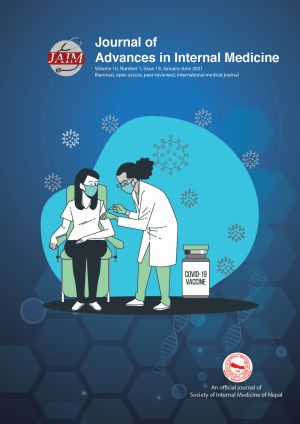Outcome of Pneumatic Balloon Dilatation in Achalasia Cardia
DOI:
https://doi.org/10.3126/jaim.v10i1.37083Keywords:
Achalasia, Eckardt score, Nepal, Ourcome, Pneumatic baloon dilatationAbstract
Background: Achalasia Cardia is a rare esophageal motility disorder. Among various treatment options, Pneumatic Dilatation (PD) is the most widely used and cost effective modality till date. This is the first observational study aiming to evaluate the short term response and complications of PD for Achalasia Cardia in Nepal.
Methods: This prospective observational study was conducted between 28th Jan 2020 to 27th Jan 2021. It included 39 patients with Achalasia Cardia diagnosed by clinical presentation, esophagoscopy, barium esophagogram and high resolution manometry. Two patients of Type III achalasia were excluded from study. Thirty seven patients underwent pneumatic dilatation with 30 mm Rigiflex balloon (Boston Scientific, USA) for a duration of 1 minute. Response was assessed by Eckardts score at 3 and 6 months.
Result: Among 39 cases (mean age= 39.03±15.017 years, 59% men), commonest was Type II Achalasia (71.8%) followed by Type I (23.1%) and Type III (5.1%). Dysphagia was present in all patients (100%), followed by weight loss (84.6%), regurgitation (79.5%) and chest pain (35.9%). Mean basal Eckardts score and Lower Esophageal Sphincter pressure of the study population was 7.81±1.24 and 24.40±6.83 respectively. Response to pneumatic dilatation was 89.2%. Eckardts score changed significantly from7.81±1.24 to 1.03±1.82 at 6 months (p<0.001). None of the patients had major complications. Younger age (23±6.377 years) had poor response to treatment, while predilatation Lower Esophageal Sphincter pressure, gender and type of achalasia did not affect the treatment outcome.
Conclusion: PD is safe and effective treatment modality for Achalasia. Younger patients have poor response to treatment with Pneumatic Dilatation.
Downloads
Downloads
Published
How to Cite
Issue
Section
License
This license enables reusers to distribute, remix, adapt, and build upon the material in any medium or format, so long as attribution is given to the creator.




